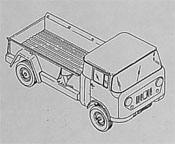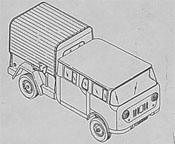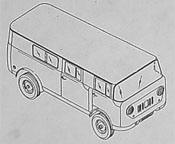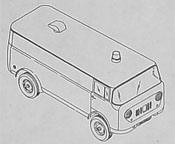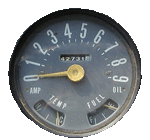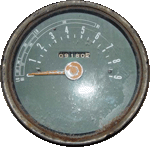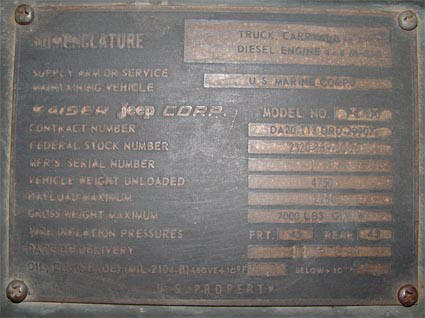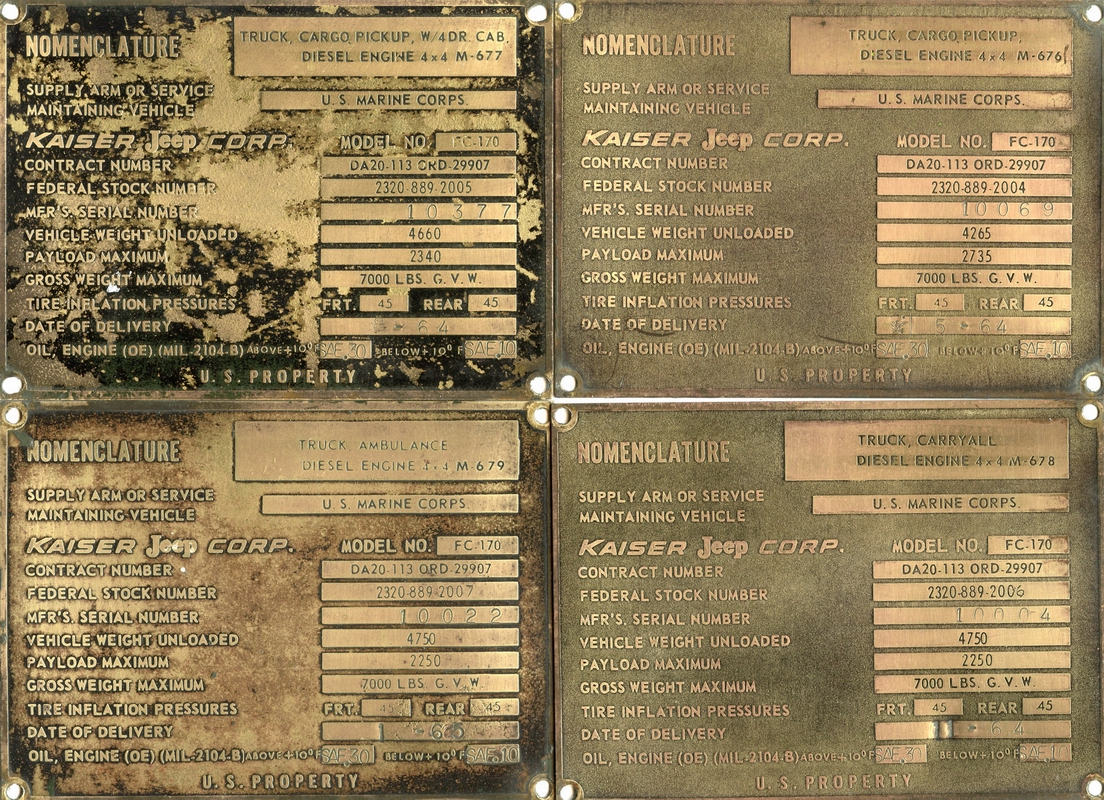Military FC Jeeps
(Or: What in the world is a M-678? and How many of these things were made?)
Known Facts:
Conjecture: Production Numbers: One of the primary goals of this page is to determine a production total for Military FCs that is as accurate as possible. Production of civilian FC-150s and FC-170s is well documented during the Willys Overland years, but records from the Kaiser years are essentially non-existent. When I purchased the M-678 the previous owner said that van production (both M-678 and M-679) was 60 total, but he did not know the breakdown between the two models. He also said that total military FC production is 400 units, but he did not know the production numbers of the M-676 or M-677 versions. He added that the first truck (unknown type) 9328?-10001* was the factory test mule, and that 9328-10002 and 9328-10003 were on Henry Kaiser's estate and given full interiors, and therefore my M-678 should be the lowest serial number FC actually delivered to the USMC. I have no proof of any of these statements, but so far they fit the known data. So my production figures will assume these statements to be correct until they are proven otherwise. Initially the answer seemed fairly simple. From the Danny Hartling's M-67X Registry and other sources, I noticed the following:
These data lead me to believe that the serial numbers were sequential for all military FCs; determined before production and differed only by prefix. Production under that assumption might look like the following: (Remember the first 3 units were supposedly not delivered)
Some of the basic assumptions here are that the Navy contract specified round numbers for convenience (20 of this, 100 of that), and the statements by the previous owner are correct (#1 was a test mule, and #2 and #3 went to Henry Kaiser). These assumptions were further supported by Fred William's M-677 #109 which has Cerlist engine number 43. Some serial number math: 109-43=66. 66 just happens to be the theorized first M-676 serial number (and therefore the first truck to receive a Cerlist motor). To me this indicated that my serial number theory was close if not exactly right on. To recap: M-678 and M-679 chassis production first and covering about 60 total units, followed by M-676 production (first to receive engines) of 40 units, followed by M-677 production. -- It just fit too nicely. UPDATE: 7/19/2005 On to Theory #2: However, since the appearance of M-679 #14 (which overlaps M-678 #20), and M-676 #123 which overlaps several M-677s. I have decided that the initial serial number pattern is coincidental. I'm now going to assume that Serial numbers started with 10001 for each of the four military types just as FC-150 and FC-170 serial numbers started at 10001 with the prefix identifying the model. The ultimate proof of this would be a pair of trucks whose complete serial number differed only by the prefix. If it is true that each model started out at # 10001, then determining total production is a bit trickier. Below is a table listing the serial numbers of the known survivors and production derived from the assumption that the survival rate for military FCs is 5% (5% is often stated as an average survival rate for fifties and sixties cars). My "Best guess" figures that there must be at least as many units as the highest surviving serial number and are rounded on the tens.
When totaled production becomes:
Update 4/18/2006: With the recent addition of several m-677s, the derived production number of 1000 units is higher than expected. Perhaps the survival rate for these trucks is higher than 5%. Since the serial numbers are still all under 400 even as new trucks surface, I'll continue to expect a total production somewhere between 600 and 700 figure. As always, without production documentation, that number is subject to change as new evidence is presented.
Production Methods: FC production was never more than a few thousand units per year, and was winding down to zero in 1965. Production of civilian FC-170s in 1964 (the year in which the majority of military FCs were delivered) was reportedly 1119 units. This is according to some notes found by Jim Allen . Since yearly production was measured in terms of several thousand units, I assume that there was only one production line in operation for all FC production. A large spread in delivery dates for the military versions seems to support this assumption. With one production line, Kaiser-Willys would have examined different options for producing the four different body styles specified in the contract. Recalling the original owner's statement about production, "60 total vans, 400 vehicle total" we can assume that it would be unprofitable to tool up the line for full scale production of each model. The simplest solution would be hand production of parts and bodies for the most unique vehicles (the vans) In addition to the low production numbers, some very crudely made interior pieces also indicate that the vans were handmade. When you inspect the underside of the of a M-678 van, the body shows remnant sheet metal bracing found on the rear of a standard cab FC-170. From this, I believe the first 60 chassis were either only partially constructed FC-170 standard cab models (cowl and windshield only), or perhaps were completed cabs on frame that were later cut in half. Either way, These early chassis were partially completed and then most likely moved to a storage facility (parking lot) and then on to an open floor for construction of the custom van bodies as space and labor permitted. M-677s production (approx 400 units) may have been enough to merit inclusion as a regular production model on the line. Delivery dates obtained from the mil data plates indicate that the van bodies (all with low serial numbers) were delivered many months after many of the higher serial numbered M-677s and M-676s. My M-678 (#4) has a delivery date of 11-64. M-678 #20 has a delivery date of 10-64. The 677s have earlier dates of delivery (mostly 5-64 and 6-64) and all have higher serial numbers than the vans. The Cerlist engine serial numbers however are lowest in the vehicles with the earliest deliver dates. My Cerlist is #215. This is evidence that because of the hand finishing required, the van chassis did not receive their engines until after their bodies were finished. Again, this is a working model and subject to change as more information comes along. Please don't neglect to e-mail me with any insights or information you may have related to military production. |
|||||||||||||||||||||||||||||||||||||||||||||||||||||||||||||||||||||||||||||||||||||||||||||||||||||||||||||||||||||||||||||||||||||||||||||||||||||||||||||||||||||||||||||||||||||||||||||||||||||||||||||||||||||||||||||||||||||||||
|
Selling the Concept Kaiser proposes the diesel powered FC to the D.O.D. Recently Dan Laity was on the forum and spoke of some material in his possession that regarded Kaiser Motors attempt at acquiring a military contract for the Forward Control vehicles that the company had been producing since 1957 based on the FC-170 truck. They had received information that Chrysler was losing their contract for the M37 that they had provided and there could be a gap before the new vehicle (The Gamma Goat, Mil. Contract - 1968) would be online. Kaiser officials felt that the FC-170 with a diesel motor could possibly fill the bill. With serious doubts of the Gamma goat final production status the decision was to provide a proposal brochure to the Department of Defense on the new diesel powered FC-170. Below is the brochure that Kaiser had in their possession and also a few other memos on the proposal and a draft of how it should look. It is unsure if the 1963 Comparison study was used verbatim or as a outline for the 1964 proposal but it is indeed some very interesting reading. The Comparison study... FC-170 vs. Ram-I is a hand written outline and a little tough to read but I would guess compares the FC to the proposed Gamma Goat. Note at the time the Gamma Goat was a gasoline (Corvair) powered vehicle. |
|
Comparison study... FC-170 Cerlist Pick-up vs. M37 May 1, 1963 |
INTER-OFFICE CORRESPONDENCE Kaiser Motors November 17, 1964 |
Comparison study... FC-170M vs. Ram I Unknown date (notes) |
Many thanks to Dan Laity for providing this information.
Update - April 2011
Common used
Maintenance Items for the M-Series FC's
Dan Horenberger has compiled a list of maintenance parts that are needed in a stock M-677 and kindly sent the information to me. If any others have anything to add please email me and I'll get it up there.
|
MOTOR MOUNTS |
NAPA number A2279 (buy them you will need it) |
| AIR FILTER | NAPA number - 542009 and they aren't cheap. |
| OIL FILTER | Fram CH33APL |
| LOWER RADIATOR HOSE | NAPA #8076 (top hose is straight) |
| MISC HOSE | There is also a small around 1" hose with a sharp bend. Never got a NAPA number just matched one up off the shelf that was way longer and cut it. |
| BELTS | Standard Bearing. Here are the part numbers. BLT400J7, and BLT490J7 they are 7 groove. |
| WIRING HARNESS |
http://www.vintagewiringofmaine.com/ They need to know if you have
military bayonets or if the headlight wiring goes to a junction strip.
If you have a junction strip you may want to change to bayonets. Most
new 24 volt headlights have built in bayonets. Or you can order while they last new 24 volt headlights without from NAPA# # 4800 or GE bulb #4800 but are not always in stock. |
| DIESEL ADDITIVE | The new diesel fuel has less sulfur then the injector pumps like.
My injector guy suggested a Stanadyne fuel additive for low sulfur but there are others. |
|
M-Series Service Manual Kevin Millage was kind enough to share a PDF copy of the M-Series Service manual with us. Check it out below |
Update - April 2015
M-Series Data Plates
Recently Dan Horenberger contacted a gentleman from Poland who was advertising reproduction Data Plates for Jeep models including the Forward Control Jeep models. He had posted a M-677 data plate which had not been available in the past. Dan has in his possession all 4 different M-Series Data Plates and was kind enough to get detailed pictures with the exact specs for reproduction to this gentleman and is awaiting his response. Dan had commented, "Interesting how each one has a different nomenclature, fed stock number and weights. Plus sure is nice to have all 4 sitting here to take pictures of." Yeah, I bet it is! Apparently the gentleman from Poland is also able to reproduce the stock civilian ID plates and they should be in the works soon. Many thanks to Dan for sharing the pictures of these plates to the FC Connection and for his meticulous description of each part so all Forward Control Jeep owners can have the exact reproduction plates for their vehicles in the near future.
Back to
Military Forward
Control Jeeps
